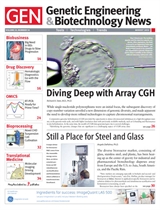Sep 4 2013
Myriad Genetics expanded its collaboration with AstraZeneca, affirming that it will work to develop companion diagnostics for the olaparib Phase III clinical development program. Olaparib is an investigational orally active poly-ADP ribose polymerase (PARP) inhibitor being developed by AstraZeneca for the treatment of various tumor types including BRCA-mutated breast and ovarian cancers. It induces synthetic lethality in homozygous BRCA-deficient cells.
Under the expanded agreement, Myriad will build out a new laboratory within its Salt Lake City facility in accordance with U.S. FDA regulations for companion diagnostic devices. In August, the FDA approved Myriad's filing for an Investigational Device Exemption (IDE) for BRACAnalysis®, a diagnostic test to confirm the presence of a BRCA gene mutation. The IDE enabled clinical studies with olaparib to include BRACAnalysis testing as a companion diagnostic.
The expanded collaboration builds on an existing agreement through which Myriad provided supply of BRACAnalysis to support the Phase II development program for olaparib in breast and ovarian cancers. Specific terms were not disclosed.
"Our hope is that the Phase III development program for olaparib will result in a new treatment option for patients suffering from BRCA-mutated ovarian and breast cancers, accompanied by a diagnostic to help physicians identify the patients for whom the therapy might be most appropriate," said Ruth March, vice president and head of personalized healthcare and biomarkers at AstraZeneca.
Phase II clinical data presented at ASCO 2013 demonstrated that patients with BRCA-mutated ovarian cancers received the most clinical benefit from maintenance treatment with olaparib.

 This article was reprinted from Genetic Engineering & Biotechnology News (GEN) with permission from Mary Ann Liebert, Inc., publishers. Genetic Engineering & Biotechnology News (GEN) has retained its position as the number one biotech publisher around the globe since its launch in 1981. GEN publishes a print edition 21 times a year and has additional exclusive editorial content online, like news and analysis as well as blogs, podcasts, webinars, polls, videos, and application notes. GEN's unique news and technology focus includes the entire bioproduct life cycle from early-stage R&D, to applied research including omics, biomarkers, as well as diagnostics, to bioprocessing and commercialization.
This article was reprinted from Genetic Engineering & Biotechnology News (GEN) with permission from Mary Ann Liebert, Inc., publishers. Genetic Engineering & Biotechnology News (GEN) has retained its position as the number one biotech publisher around the globe since its launch in 1981. GEN publishes a print edition 21 times a year and has additional exclusive editorial content online, like news and analysis as well as blogs, podcasts, webinars, polls, videos, and application notes. GEN's unique news and technology focus includes the entire bioproduct life cycle from early-stage R&D, to applied research including omics, biomarkers, as well as diagnostics, to bioprocessing and commercialization.